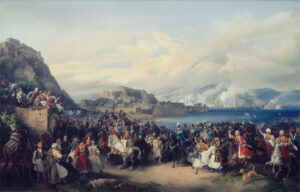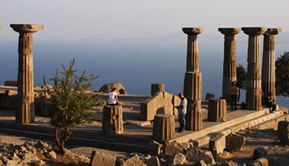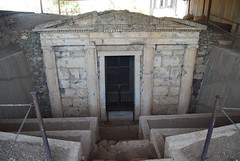The Greek Revolution of 1821: An Overview
Roderick Beaton traces the history of the Revolution and shows why, 200 years on, it still matters

‘The Entrance of King Otto of Greece into Nauplia’, Peter von Hess, 1835, Bayerische Staatsgemäldesammlungen, Neue Pinakothek, Munich (https://www.sammlung.pinakothek.de/en/artwork/jpxeVRVLJ7 CC BY-SA 4.0)
The Greek Revolution was an uprising in the European provinces of the Ottoman Empire by its Greek-speaking, Orthodox Christian subjects. It resulted, after more than ten years of horrific violence on both sides, in the creation of Greece as an independent nation-state. Sometimes called, in English, the ‘Greek War of Independence’, the conflict marked a number of ‘firsts’ in European history.
It was the first liberal-national revolution in Europe to succeed, following the successful revolution against British rule in the USA (1775–83) and the French Revolution which began in 1789, but led to the Napoleonic Wars which ended with the defeat of France in 1815. Greece was the first of many nation-states to come into existence in the Old World of Europe from that time to the present. And this was the first conflict (perhaps in all world history) which drew outsiders from many countries, either to volunteer on the battlefield or to organise support in their own countries, without any apparent ulterior motive for doing so.
It began on 6 March 1821 (or 22 February according to the calendar in use in southeastern Europe at the time). A one-armed senior officer of the Russian imperial army slipped across the river Pruth, with a handful of retainers, from what was then Russian territory into Ottoman-controlled Moldavia (today part of Romania). Like many high-ranking Russians in those days, his native language was Greek. His name was Alexandros Ypsilantis, and he was the leader of a conspiracy, known as the Philiki Etaireia, or Friendly Society. The Society had secretly been recruiting members for a number of years among Greeks of the Ottoman Empire and Europe. Its aim was revolution: by violent means to throw off the ‘yoke’ of Ottoman Turkish rule. Quite what was to happen after that, nobody seemed to know.
Between April and June, as news of the insurrection in the Balkans spread, spontaneous uprisings took place in many different parts of today’s Greece. From Thessaloniki in the north to Kalamata and the mountains of Mani in the south, and on several islands, Greeks rallied to the standard of revolt. Despite some initial successes, in most of those regions the movement was quickly snuffed out by brutal Ottoman reprisals. Ypsilantis’s campaign in the Balkans collapsed after defeat at the Battle of Dragashan on 19 June. It was only in the Peloponnese and on some of the islands that the Revolution took hold – chiefly Hydra and Spetses close to the coast of the Peloponnese, Psara and Samos on the other side of the Aegean, and Crete.
The story has often been repeated that the standard of revolt was raised by the Bishop of Old Patras at the monastery of Agia Lavra, above the town of Kalavryta in the northwest of the Peloponnese, on the day of the Christian festival of the Annunciation on 25 March (the date still celebrated in Greece as a national holiday). It is almost certainly apocryphal. But once violence had broken out spontaneously in several different parts of the peninsula, there was no going back. Local leaders, backed by former brigands and irregular bands of their armed followers, seized the initiative and swept across the country.
A decisive moment came in October 1821. Tripolitsá (today’s Tripoli, in the centre of the Peloponnese, and at the time the largest town) fell to the insurgents after a long siege. The victors went on to violate the terms of surrender. In the aftermath, some 8000 Muslim and Jewish inhabitants were slaughtered. By the end of the year, most of the southern part of today’s Greek mainland – and several islands in the Aegean – had been ‘liberated’ – by which was meant a form of ‘ethnic cleansing’ of their Muslim inhabitants that was scarcely less brutal than the reprisals meted out by the Ottoman state.
The aftermath of the taking of Tripolitsá would seriously damage the image of the Revolution abroad. But it was soon followed by even greater savagery shown by the Ottomans to the Greek inhabitants of the island of Chios during the spring and summer of 1822. The Chiots had refused to have anything to do with the Greek insurgency elsewhere. But a provocative attack on the Ottoman garrison by revolutionaries from nearby Samos sparked a massive escalation by the authorities in Istanbul. By the end of the summer of 1822, after three months of mayhem, only 30,000 of the 100,000 Greeks who had lived in Chios before the Revolution were left. The rest had been killed, sold as slaves, or escaped to islands under Greek control.
Sultan Mahmud was now determined to crush the revolt in its heartland. In the summer of the same year, two Ottoman armies struck down through the mountain passes of central Greece. One succeeded to the extent of wiping out a small army, mostly made up of foreign volunteers, at the Battle of Peta, near Arta in western Greece, on 16 July. But later the troops were forced to retreat after laying siege to the main town of the region, Missolonghi, for several months. The other, after marching down the eastern side of the country and failing to relieve the beleaguered Ottoman garrison of Nafplio in the northeast of the Peloponnese, was annihilated in a daring ambush in the pass of Dervenakia, near Corinth, just ten days after the Greek defeat at Peta. The Greeks had won themselves a relative breathing space. It would last (more or less) for two and a half years. This was their chance to set their own affairs in order.
At the end of 1821, a first ‘national assembly’ in Greece had brought together representatives from all the areas that had been liberated, to draw up a constitution. The ‘Epidaurus Constitution’, as it has become known ever since, was way ahead of its time. Based on aspects of the constitutions of revolutionary France and on the US Constitution, it laid down many of the principles that we recognise today as defining a modern, democratic state. Greece was to be a republic; its citizens were to enjoy equal rights; legislative and executive powers were to be separated. Citizens of the new state were defined, for the first time formally, by the ancient name of ‘Hellenes’ and the state as ‘Hellas’ (the ancient geographical name equivalent to ‘Greece’ in English).
A second national assembly in the spring of 1823 brought to the surface underlying tensions between the architects of successive ‘provisional constitutions’, on the one hand, and the warlords and leaders of irregular guerrilla groups whose actions had done the most to liberate those parts of the country that were now free. It is often said that every revolution brings in its train a civil war; the Greek Revolution was no exception. Civil war broke out twice during 1824: in late spring and again in December.
Victory went to the politicians; the warlords were finally forced to sign up to the constitutional framework of a modern state, as it had been envisioned in the Epidaurus Constitution. It was the outcome of this internal conflict, the first of several civil wars that the Greek state has endured in its 200-year history, that ensured the future shape of Greece, as we know it today, and its place in the European family of nations. This was because the political vision that prevailed after the civil conflicts of 1824 was predicated on the idea that a newly independent Greece would be crucially dependent on economic and diplomatic support from the Great Powers of Europe. This determination came not a moment too soon.
The sultan had taken his time about reclaiming the provinces he had lost to the insurgents, after his forces had been beaten back in 1822. By the spring of 1825 he had come up with a plan that was very nearly foolproof. His vassal, Muhammad Ali of Egypt, was induced to contribute a newly modernised fleet from Alexandria, under the command of his son Ibrahim Pasha. While Ottoman land forces once again moved down from the north, Ibrahim landed on the south coast of the Peloponnese in February 1825. Over the next two and a half years, the Ottoman army and the Egyptian fleet between them reversed nearly everything that the Greeks had gained since 1821. By the early summer of 1827, liberated Greece had all but disappeared.
It was intervention from abroad that turned the tide. Right from the start, some, at least, of the Greek revolutionary leaders had made well publicised appeals to the governments and peoples of Europe for aid in their struggle. In 1824 and 1825 large loans to the provisional government had been negotiated with banks and private speculators in London. Much about these loans was controversial at the time and has remained so ever since; waste and corruption were as evident among British financiers as they were in revolutionary Greece. And it is true that this early financial dependence set a precedent that would be repeated again and again in the later history of independent Greece, down to the financial crisis of 2010-2019. But it is also the case that foreign investment, at this early stage of the conflict, while its outcome still hung in the balance, was one of the factors that focused the minds of governments abroad. And the promise of desperately needed financial assistance, when the provisional government was under threat, first of all from the warlords of its own side, and then more existentially from Ibrahim’s forces in the Peloponnese, proved a vital lifeline in maintaining Greece’s path from violent insurrection to emergence as a viable modern state in the 1830s.
But at least as important as hard-headed economics was another factor, which did more than anything else to force governments abroad to take seriously the case for Greek independence. Between 1821 and 1826, from all over Europe, and even as far away as the United States of America, volunteers arrived in Greece to take up arms in the struggle. They were known as ‘philhellenes’ (lovers of things Greek). They were never very numerous – about 1200 in total. And a high proportion of those were either killed in battle or died of disease, as happened to the most famous of them all, the British poet and celebrity Lord Byron, who succumbed to fever at Missolonghi on 19 April 1824.
High-profile deaths such as Byron’s, and harrowing stories sent back from the front, did much to arouse sympathy for the cause back in the volunteers’ home countries. More influential than the volunteers in arms was what has been called ‘the philhellenism of the home front’. During the 1820s, all over Europe and in the USA, local, voluntary committees were set up and fundraising initiatives established. Campaigns were mounted in the press wherever newspapers and journals were able to circulate freely. It seems that many thousands of individuals and diverse communities, across national and state borders, were mobilised. By the middle of the decade, philhellenism had become a Europe-wide movement.
The motivation behind all this activity varied. Some philhellenes were adventurers or political idealists, supporters of the French Revolution and latterly of Napoleon, who had become misfits in the new Europe after 1815. Some, particularly on the home front, were susceptible to the long-defunct ideology of the Crusades, and rallied to the cause of fellow-Christians embattled against the forces of Islam. (And indeed, for most Greeks on the ground, it was for their Orthodox religion that they were fighting, rather than for more abstract and newfangled ideas of political self-determination.) But what gave fire to the philhellenic movement abroad was the prestige among educated Europeans and Americans of the ancient civilisation of Greece, that was increasingly being seen as the fountainhead of the arts and sciences, the laws and politics of what we now call the modern western world. The philhellenes were prepared to risk their lives in somebody else’s war, or to exert themselves at home to support its aims, because they believed that they, too, had a stake in the conflict. They were repaying a debt that they felt they owed to the origin of their own civilisation.
Governments abroad, on the other hand, were much more reluctant to become involved. At first, every approach on behalf of the Greeks had been rebuffed. Even in 1825, when the Greek leadership, united for once, addressed a formal appeal to the government of Great Britain for Greece to be taken under that country’s protection, it was turned down. It was very much thanks to the activities of the philhellenes at home that, by 1826, the governments of the three naval powers that had interests in the eastern Mediterranean – Great Britain, France and Russia – embarked on a delicate series of negotiations, not with the Greeks, but with each other. If Ottoman power was going to be seriously weakened in Europe, it would matter a great deal to each of the three that neither of the others should gain a geopolitical advantage from the outcome. So began the ‘Eastern Question’, that would not be resolved until the aftermath of World War I.
In 1827, the three powers agreed to send a joint naval task force into the Aegean, charged with enforcing a truce between the belligerents. Not surprisingly, the Greeks welcomed this sign of military intervention. The Ottoman authorities, from the sultan downwards, had consistently maintained that the rebellion by some of his Christian subjects was a purely internal matter for the empire to deal with as it saw fit; no foreign power had the right to try to intervene. And so the stage was set for one of the few great set-piece battles of the entire war, the Battle of Navarino. Instead of imposing peace, the squadrons of the three allied navies ended up engaging the combined fleets of the sultan and of his Egyptian vassal in Navarino Bay, off the southwest coast of the Peloponnese, on 20 October 1827. The task force under the command of the British admiral Edward Codrington had only a third as many ships, but their firepower was far superior. The Egyptian and Ottoman fleets were all but destroyed at their anchorage.
In the aftermath, France sent troops to Greece to enforce the withdrawal of all Ibrahim’s land forces from the Peloponnese. They also accepted the surrender of the Ottoman garrisons of those fortresses that had held out since the beginning of the Revolution. The French soldiers and their officers were no longer ‘philhellenes’, in the sense of individual volunteers: they were acting under orders from the government in Paris. A final strand of international intervention took the form of a war between the Russian and Ottoman empires. Fought mostly far from Greece, this was one of a long-running series of such conflicts; Greece was not its principal cause. But when the Ottomans lost, and Russian troops reached as far as Edirne (Adrianople), only about 240 kilomiles from Constantinople, the sultan was forced to agree to the victor’s terms in September 1829.
This gave to the three Great Powers that had fought at Navarino the unfettered right to determine the outcome of the Greek Revolution. By this time, a third national assembly of the Greeks had appointed an interim head of government for the state that still had no formally recognised existence. His name was Ioannis Kapodistrias, also known as Count John Capo d’Istria. Originally from Corfu, he had spent many years in Russia and even served as Russian foreign minister. Now freed from his obligations to the tsar, Kapodistrias arrived in the Peloponnese early in 1828, with the title of ‘Governor’.
Kapodistrias was at once an outsider – he had never been to mainland Greece before – and a Greek. He worked energetically to lay the foundations for a modern state. He established a system of education and encouraged the founding of new schools using the latest experimental methods from Britain and continental Europe. He introduced Greece’s first modern currency, based on a coin called the phoenix, and an embryonic national bank. He organised the judiciary. He did his best to negotiate the most favourable terms for Greece with the representatives of the three Great Powers. But it was they, not the Greek Governor, who took the decisive step that would ensure the independence of Greece.
On 3 February 1830, a diplomatic protocol was signed in London by the British Foreign Secretary, Lord Aberdeen, and the ambassadors of France and Russia. Under the guarantee of their respective governments, it declared, ‘Greece will form an independent State, and will enjoy all those rights – political, administrative, and commercial – attached to complete independence’. This was the turning point.
A year and a half later, in Greece, Kapodistrias was assassinated by two political opponents. During the last months of 1831, the country once again lapsed into civil war. The Great Powers had been slow to follow up on their initiative – thanks to a series of upheavals nearer home. By this time, it had already been decided that the new state must be a monarchy, not a republic as its provisional constitutions had stipulated. In May 1832, a new treaty, again signed in London, determined that Prince Otto, the second son of the philhellene King of Bavaria, Ludwig I, would be the first king. Frontiers for the kingdom were drawn up at the same time. They included only the Peloponnese, less than half of mainland Greece as it is today, and those islands closest to it in the Aegean. The remainder was still part of the Ottoman empire, except for the Ionian Islands, which had been awarded to Great Britain to rule as a protectorate in 1815.
The Greek Revolution formally ended on 6 February 1833, when the future king, Prince Otto, arrived at Nafplio aboard a British warship. This was the moment when Greece (‘Hellas’ in Greek) took its place among the political states of Europe, for the first time, in all the long history of the Greeks.
Recommended Reading:
Mazower, M., The Greek Revolution: 1821 and the Making of Modern Europe, Allen Lane, 2021









